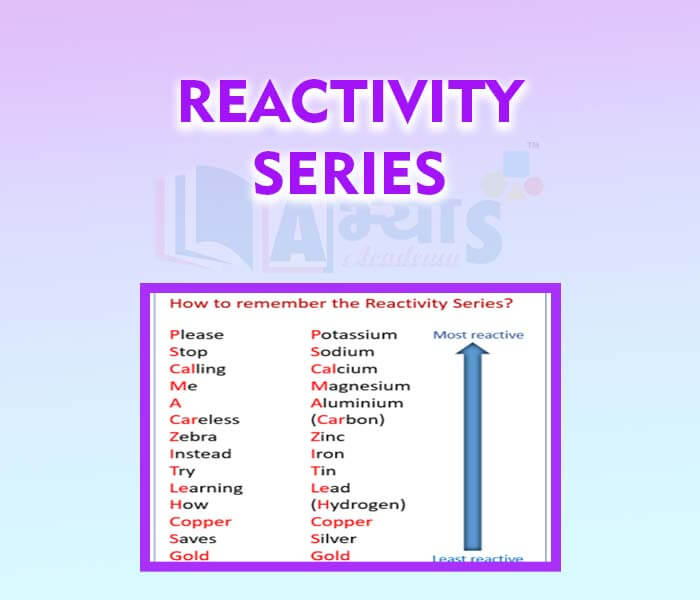Reactivity Series







Reactivity Series
Reactivity Series:
The reactivity series of the metals, also known as the activity series, refers to the arrangement of metals in the descending order of the reactivities. The reactivity of metals differs from metal to metal. Some of the metals are more reactive, while others are less reactive towards chemical reagents. The metals that can lose electrons easily and form positively charged ions are more reactive. Those that cannot lose electrons easily are less reactive. Metals can be arranged in the order of decreasing reactivity in a series. This series is called the activity or reactivity series of metals.
The series has been derived after studying many chemical reactions. Copper (Cu), mercury (Hg) and silver (Ag) react with HNO3, but do not produce H2. In these reactions, the metal is oxidized to the metal ion and ion is reduced to
or other nitrogen species. It may be asked, why hydrogen, being a nonmetal, has been included in the activity series. It is because hydrogen, like metals, can part with its electron to form a positive ion or cation.
Which of the following are correct : (a) Potassium is the highly reactive metal. (b) Gold is the least reactive metal. | |||
| Right Option : C | |||
| View Explanation | |||
The metals that can _______________ electrons easily and form positively charged ions are more reactive. | |||
| Right Option : A | |||
| View Explanation | |||
Which of the following are correct : (a) The metals that can lose electrons easily and form positively charged ions are more reactive. (b) The metals that do not lose electrons easily are less reactive. (c) The metals that do not lose electrons easily are more reactive. | |||
| Right Option : A | |||
| View Explanation | |||
Students / Parents Reviews [10]
Abhyas is a complete education Institute. Here extreme care is taken by teacher with the help of regular exam. Extra classes also conducted by the institute, if the student is weak.

Om Umang
10thA marvelous experience with Abhyas. I am glad to share that my ward has achieved more than enough at the Ambala ABHYAS centre. Years have passed on and more and more he has gained. May the centre flourish and develop day by day by the grace of God.

Archit Segal
7thIt was a good experience with Abhyas Academy. I even faced problems in starting but slowly and steadily overcomed. Especially reasoning classes helped me a lot.

Cheshta
10thMy experience with Abhyas is very good. I have learnt many things here like vedic maths and reasoning also. Teachers here first take our doubts and then there are assignments to verify our weak points.

Shivam Rana
7thMy experience with Abhyas academy is very good. I did not think that my every subject coming here will be so strong. The main thing is that the online tests had made me learn here more things.

Hiya Gupta
8thIt has a great methodology. Students here can get analysis to their test quickly.We can learn easily through PPTs and the testing methods are good. We know that where we have to practice

Barkha Arora
10thBeing a parent, I saw my daughter improvement in her studies by seeing a good result in all day to day compititive exam TMO, NSO, IEO etc and as well as studies. I have got a fruitful result from my daughter.

Prisha Gupta
8thOne of the best institutes to develope a child interest in studies.Provides SST and English knowledge also unlike other institutes. Teachers are co operative and friendly online tests andPPT develope practical knowledge also.

Aman Kumar Shrivastava
10thIt was good as the experience because as we had come here we had been improved in a such envirnment created here.Extra is taught which is beneficial for future.

Eshan Arora
8thAbout Abhyas metholodology the teachers are very nice and hardworking toward students.The Centre Head Mrs Anu Sethi is also a brilliant teacher.Abhyas has taught me how to overcome problems and has always taken my doubts and suppoeted me.
